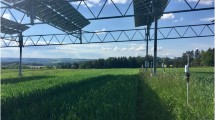Abstract
Shade-induced changes in the branching pattern of clonal plants can lead to conspicuous modifications of their growth form and architecture. It has been hypothesized that reduced branching in shade may be an adaptive trait, enabling clonal plants to escape from unfavourable patches in a heterogeneous environment by allocating resources preferentially to the growth of the main axis (i.e. linear expansion), rather than to local proliferation by branching. However, such an adaptionist interpretation may be unjustified if (1) branching frequency is a function of the ontogenetic stage of plants, and if (2) shading slows down the ontogenetic development of plants, thereby delaying branch formation. In this case, architectural differences between sun- and shade-grown individuals, harvested at the same chronological age, may not represent a functional response to changes in light conditions, but may be a by-product of effects of shade on the rate of plant development. To distinguish between these two alternatives, individuals of the stoloniferous herb Potentilla reptans were subjected to three experimental light conditions: a control treatment providing full daylight, and two shade treatments: neutral shade (13% of ambient PPFD; no changes in light spectral composition) and simulated canopy shade (13% PPFD and a reduced red:far-red ratio). Plant development was followed throughout the experiment by daily monitoring primary stolon growth as well as branch and leaf initiation. Biomass and clonal offspring production were measured when plants were harvested. At the end of the experiment shaded plants had produced significantly fewer branches than clones grown in full daylight. In all three treatments, however, initiation of secondary stolons occurred at the same developmental stage of individual ramets. Shading significantly slowed down the ontogenetic development of plants and this resulted in the observed differences in branching patterns between sun- and shade-grown individuals, when compared at the same chronological age. These results hence provide evidence that shade-induced changes in the branching pattern of clonal plants can be due to purely allometric effects. Implications for interpreting architectural changes in terms of functional shade-avoidance responses are discussed.
Similar content being viewed by others
Author information
Authors and Affiliations
Additional information
Received: 16 August 1996 / Accepted: December 1996
Rights and permissions
About this article
Cite this article
Huber, H., Stuefer, J. Shade-induced changes in the branching pattern of a stoloniferous herb: functional response or allometric effect?. Oecologia 110, 478–486 (1997). https://doi.org/10.1007/s004420050183
Issue Date:
DOI: https://doi.org/10.1007/s004420050183




